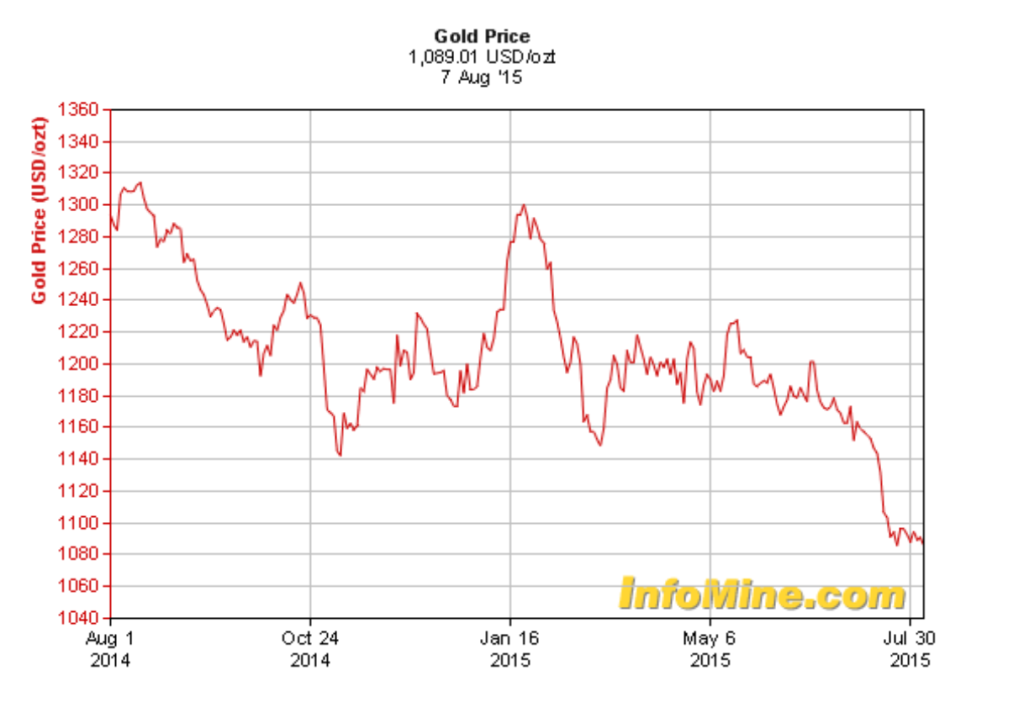In January 2015, the London Bullion Market Association (LBMA) issued the results of its annual forecast for prices of gold. The 35 forecast contributors expected gold prices to remain broadly flat in 2015, with an average gold price of $1,211 an ounce. The trading range during the year was expected between $1,085 to 1,356. The lowest prediction was an average yearly price of $950. The highest average was forecasted at $1,321.
Gold began 2015 at about $1,175 an ounce. By January 23, it had rallied to almost $1,300. In February, it slipped about $60 and the fall continued in March. After a brief consolidation, it has been on a downtrend since June. Since July 20, 2015, when gold slipped below $1,100, it has remained in that region so far.

So, where is headed?
As the LBMA forecast shows, it is dangerous to stick your neck out and state a precise figure. However, analysts continue to make their predictions. What are they saying now? Here’s an update.
Gold will underperform, seems to be the majority opinion.
According to last month’s reports, Goldman Sachs holds that the yellow metal could fall below $1,000, while Deutsche Bank puts gold’s fair value at $750. ANZ Research has downgraded its gold forecast, noting that there had been a significant negative shift in market positioning. “While our short-term forecast of $1,100 was met recently, we were surprised at the manner in which it occurred, having previously expected a gradual grind lower,” ANZ said.
ANZ believes gold could average $1,060 this quarter and test $1,020 by December due to a stronger US dollar and weak physical demand. “The market is positioned very short and on some measures, looks even more bearish than in 2013,” it said.
ANZ said the main difference between 2013’s gold price weakness and now is that China and India are unlikely to surprise the market with strong physical demand. Website Bullion Desk states that gold is looking vulnerable as resistance persists. It says that the belief that Federal Reserve could start firming monetary policy as soon as September should now be revised somewhat given the impact on US data as exports are already starting to falter due to the strong dollar. It expects limited buying from gold ETFs and renewed selling in the futures market. With the market entering a seasonal slow period, it holds the view that the risks to gold prices in the third quarter are predominantly skewed to the downside.
Last week, HSBC strategists lowered their average annual gold price forecasts for this year, warning that gold prices are likely to remain under pressure in the short term and may “move within striking distance of $1,000” an ounce before recovering.
HSBC lowered its 2015 average annual price forecast from $1,234 to $1,160. Among the reasons for gold’s recent selloff is the “drift towards Fed tightening and the associated USD strength, low global inflationary pressure, weak gold demand from India and China and market positioning and momentum,” HSBC strategists said.
According to Nadeem Walayat, Editor, The Market Oracle, the gold price bear market has continued in 2015 since its mid-January 2015 peak. He forecasts gold price to trend lower into August 2015, targeting a low of $1,050 before it finally makes a low for the year that propels its price to above $1,300, probably spiking to approximately $1,350 during November before correcting during December. Certified Investment Adviser and long time precious metals market enthusiast, Arkadiusz Sieroń, however, strikes a different note. According to him, in the past few weeks, the price of gold has suffered a significant decline and there is negative sentiment all over the market. However, investors should remember that since gold does not generate cash flows, precise predictions based on standard financial models are very difficult.
He says that negative sentiment toward gold doesn’t mean that gold is really doomed. Sentiment changes along with price and the only thing that the gold-is-doomed comments are really saying is that we are not close to a major top but closeto a major bottom. All markets move from extreme optimism to extreme pessimism and vice-versa and it seems that the gold market is simply in the latter type of environment. Multiple long-term fundamental factors remain intact and just becausethe price of gold moved temporarily down and we read many bearish opinions doesn’t invalidate it.
The last word has, still, not been said. Come what may, everybody would watch gold prices in the coming months with lot of interest.
